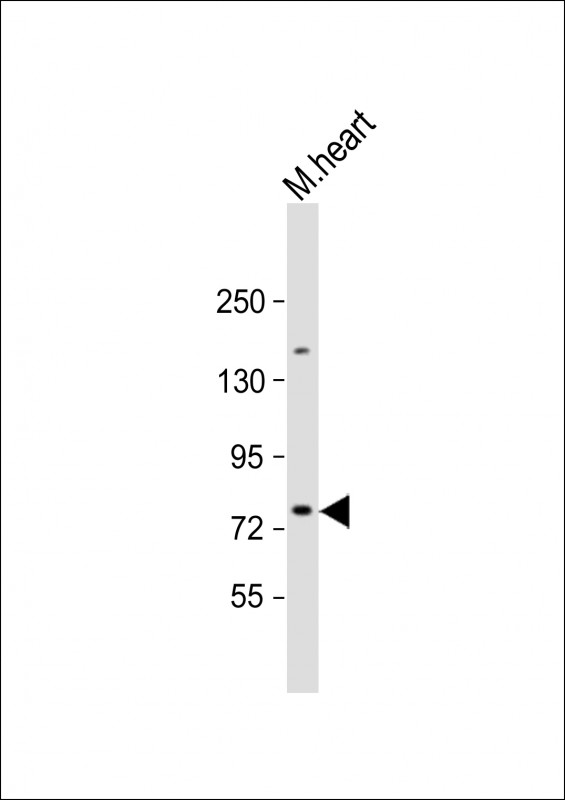
| WB | 1/2000 | Human,Mouse,Rat |
| IF | 咨询技术 | Human,Mouse,Rat |
| IHC | 咨询技术 | Human,Mouse,Rat |
| ICC | 技术咨询 | Human,Mouse,Rat |
| FCM | 咨询技术 | Human,Mouse,Rat |
| Elisa | 咨询技术 | Human,Mouse,Rat |
| Aliases | Sodium- and chloride-dependent creatine transporter 1, CT1, Creatine transporter 1, Solute carrier family 6 member 8, SLC6A8 |
| Entrez GeneID | 6535 |
| WB Predicted band size | 70.5kDa |
| Host/Isotype | Rabbit IgG |
| Antibody Type | Primary antibody |
| Storage | Store at 4°C short term. Aliquot and store at -20°C long term. Avoid freeze/thaw cycles. |
| Species Reactivity | Human, Mouse, Rat |
| Immunogen | This SLC6A8 antibody is generated from a rabbit immunized with a KLH conjugated synthetic peptide between 180-212 amino acids from human SLC6A8. |
+ +
以下是关于SLC6A8 (N-Term)抗体的3篇参考文献及其摘要内容:
1. **文献名称**: *"Characterization of a polyclonal antibody to the human creatine transporter SLC6A8"*
**作者**: Dodd JR et al.
**摘要**: 该研究开发并验证了一种针对人SLC6A8蛋白N端结构域的多克隆抗体。通过Western blot和免疫组化实验,证实该抗体能特异性识别SLC6A8.并在脑组织和肌肉细胞中检测到其表达,为研究肌酸转运缺陷症提供了工具。
2. **文献名称**: *"Localization of the creatine transporter protein in the rat central nervous system using a novel SLC6A8-specific antibody"*
**作者**: Braissant O et al.
**摘要**: 研究利用针对SLC6A8 N端的特异性抗体,通过免疫荧光和免疫电镜技术,首次在大鼠中枢神经系统神经元和胶质细胞中定位了SLC6A8蛋白,揭示了其突触和线粒体附近的分布特征。
3. **文献名称**: *"SLC6A8 deficiency: biochemical and clinical implications of cerebral creatine transporter dysfunction"*
**作者**: van de Kamp JM et al.
**摘要**: 文章总结了SLC6A8基因突变引起的肌酸转运缺陷症,利用N端特异性抗体分析了患者成纤维细胞中SLC6A8蛋白表达缺失,强调了该抗体在疾病诊断和机制研究中的关键作用。
The SLC6A8 (N-Term) antibody targets the N-terminal region of the solute carrier family 6 member 8 (SLC6A8) protein, a critical creatine transporter encoded by the *SLC6A8* gene located on chromosome Xq28. SLC6A8. also known as CRT1 (creatine transporter 1), facilitates cellular uptake of creatine, a molecule essential for energy metabolism in high-demand tissues like the brain, skeletal muscle, and heart. This sodium- and chloride-dependent transporter localizes to cell membranes and is pivotal for maintaining intracellular creatine reserves, particularly in neurons and muscle cells.
Mutations in *SLC6A8* are linked to cerebral creatine deficiency syndrome 1 (CCDS1), an X-linked disorder characterized by intellectual disability, seizures, and developmental delays due to impaired creatine transport. The N-terminal region of SLC6A8 is crucial for protein function, as it contains structural elements necessary for membrane localization and transporter activity. Antibodies targeting this domain are widely used in research to study SLC6A8 expression, trafficking, and dysfunction in disease models. They enable applications such as Western blotting, immunohistochemistry, and immunofluorescence to assess protein distribution in tissues or cultured cells. Additionally, these tools aid in investigating the molecular mechanisms underlying CCDS1 and potential therapeutic strategies, including creatine supplementation or gene therapy. The specificity of the N-Term antibody makes it valuable for distinguishing SLC6A8 from other transporters and validating knockout/knockdown models in neurological and muscular disorder studies.
×